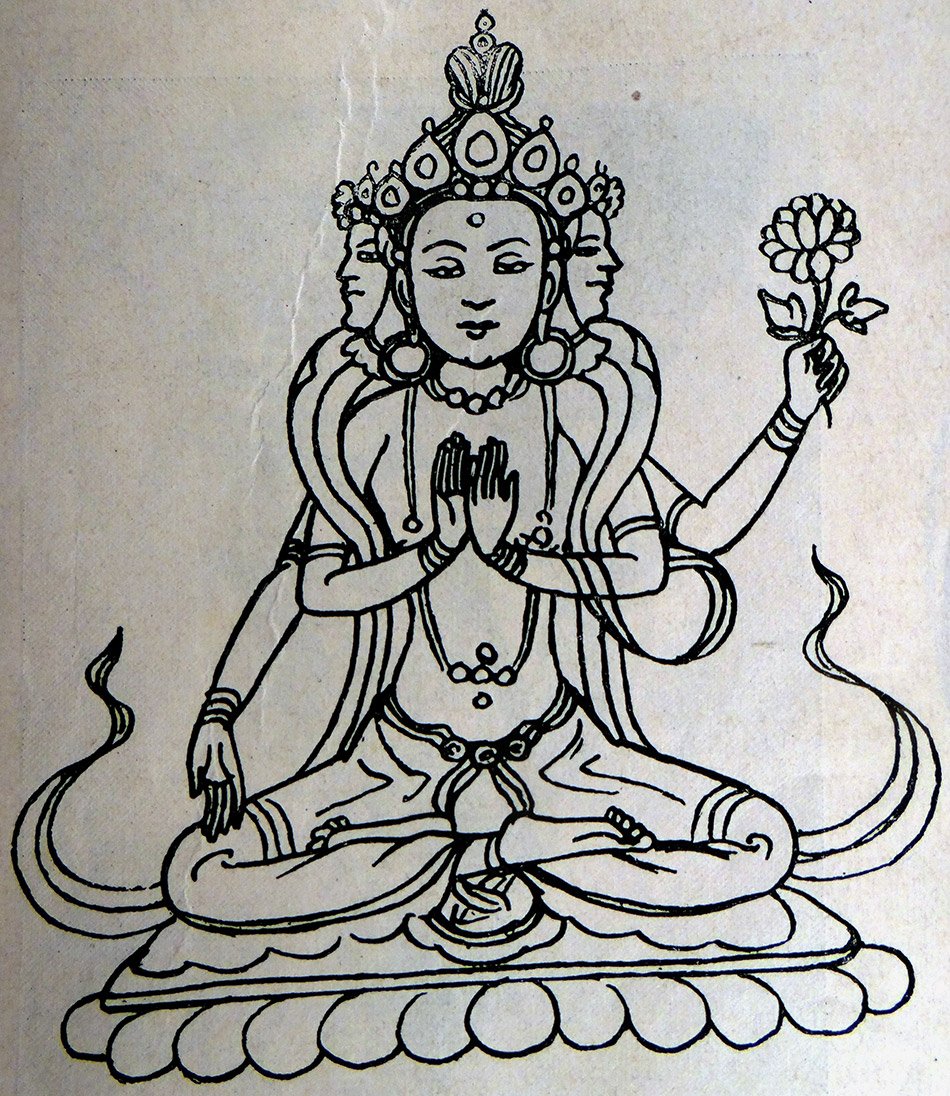The Indian Buddhist Iconography
by Benoytosh Bhattachacharyya | 1958 | 51,392 words | ISBN-10: 8173053138 | ISBN-13: 9788173053139
This page contains an iconography image of Maitreya (the future Buddha) and represents figure 47 of the book Indian Buddhist Iconography, based on extracts of the Sadhanamala English translation. These plates and illustrations represent either photographs of sculptures or line-drawing reproductions of paintings or other representations of Buddhist artwork.
Figure 47 - Maitreya (the future Buddha)

Figure 47: Maitreya
Maitreya partakes of the nature of a Mortal Buddha, though he is not a Buddha yet. He is supposed to be passing the life of a Bodhisattva in the Tuṣita heaven, preparatory to his descent to earth in human form. It is said that he will come to earth full 4000 years after the disappearance of Buddha Gautama for the deliverance of all sentient beings. Asaṅga is said to have visited Maitreya in the Tuṣita heaven and to have been initiated by him into the mysteries of Tantra. He is the only Bodhisattva who is worshipped alike by the Hīnayānists and the Mahāyānists and his images can be traced from the Gandhara School down to the present time. Hiuen Tsang records the existence of Maitreya in Udyāna (U-chang-na). The sculptor, in order to ascertain his correct form, is believed to have gone several times to the Tuṣita heaven before carving it.
Maitreya may be represented as a standing figure, adorned with rich ornaments and holding in his right hand the stalk of a lotus He is distinguished from Padmapāṇi mainly by the figure of a small Caitya which he bears on his crown. Getty remarks that in Indian sculpture he shows in his hands the usual Dharmacakramudrā; in the left there is a vase, round, oval or pointed, or there may be the stems of flowers which support his two characteristic symbols, the vase and the wheel. Maitreya may also be represented seated as a Buddha, with legs either interlocked or dangling down. His colour is yellow, and his images sometimes bear the figures of the five Dhyāni Buddhas, on the aureole behind. The small Caitya on the crown of Maitreya is said to refer to the belief that a Stūpa in the mount Kukkuṭapāda near Bodh-Gaya covers a spot where Kaśyapa Buddha is lying. When Maitreya would descend to earth he would go direct to the spot, which would open by magic, and receive from Kaśyapa the garments of a Buddha.
The Sādhanamālā furnishes us with only one description of Maitreya as a principal divinity and several others in which he is represented as a minor god. When as a minor god, he accompanies others, he generally carries the chowrie in the right hand and the Nāgakeśara flower in the left.
The Sādhana describing the procedure of his worship has Dhyāna:
“The worshipper should meditate himself as Maitreya who originates from the yellow germ syllable ‘Maiṃ’. He is three-faced three-eyed, and four-armed. His right and left faces respectively are of blue and white colour. His complexion is yellow like that of gold. He sits in the Paryaṅka attitude on an animal. His two hands are engaged in exhibiting the Vyākhyāna Mudrā and he shows in his other right and left hands the Varada Mudrā and a full-blown Nāgakeśara flower with its branches He is decked in many ornaments. Meditating thus...
This is the Sādhana for Maitreya”.
A Nepalese drawing (Fig. 47) represents this form of Maitreya which follows the Dhyāna in all .details except the vehicle. Maitreya is popular in Tibet and his images are found in abundance in China.
